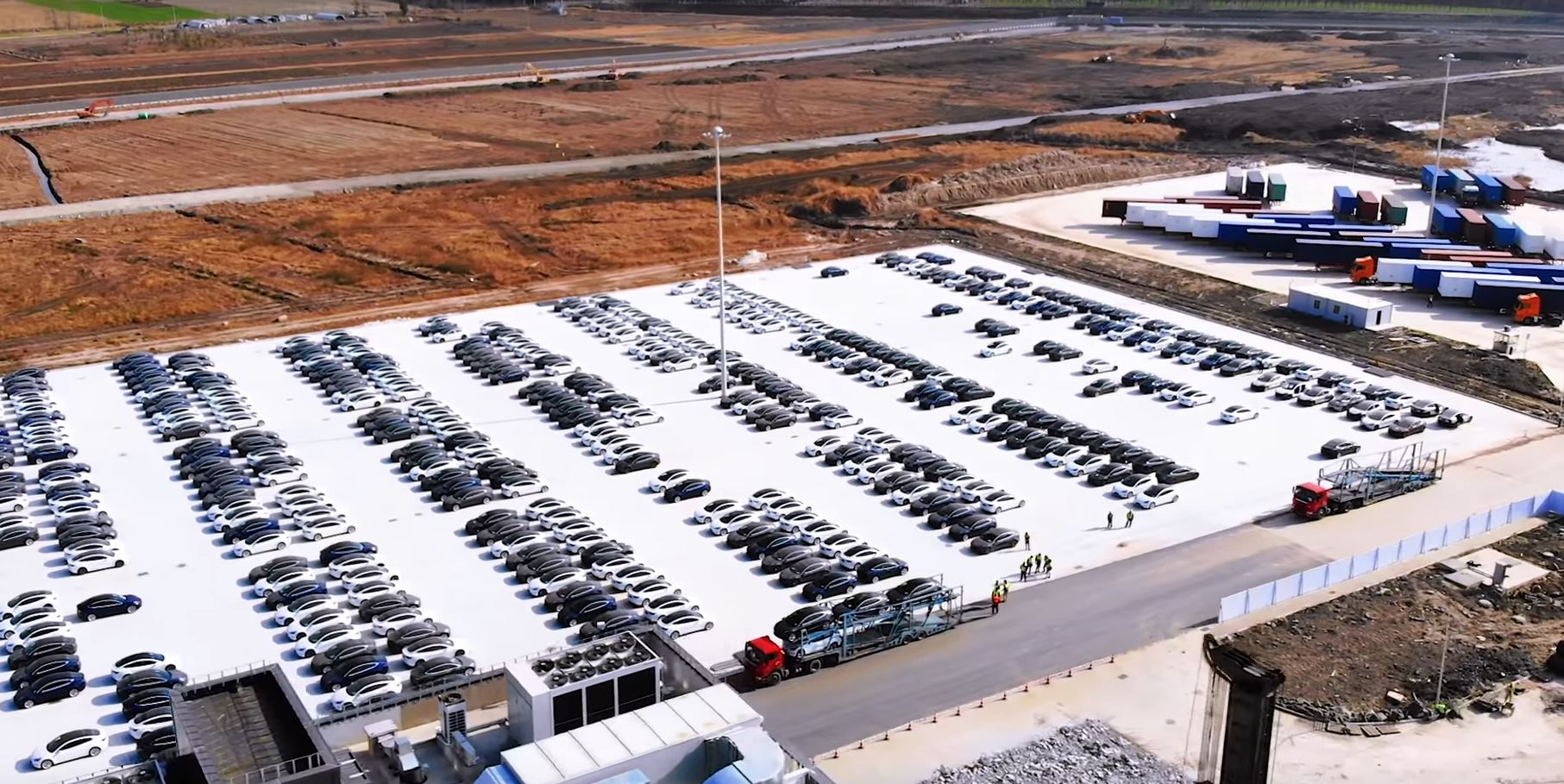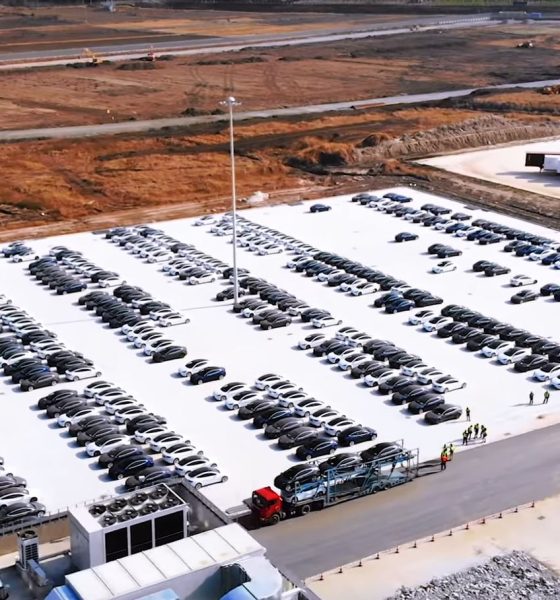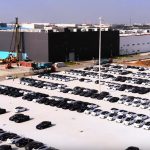

News
Tesla’s China factory ramps Model 3 mass production ahead of first local deliveries
Tesla is expected to deliver the Made-in-China (MIC) Model 3 soon and it has now become normal to see Gigafactory 3’s holding lots filled with hundreds of electric cars. In recent days, more transport trucks have been seen leaving the facility to bring vehicles to delivery centers across China.
The recent video posted by drone operator Jason Yang on YouTube showed the busy grounds of Gigafactory 3 as Tesla staff moved locally-made Model 3 units from the parking lot to transport trucks. Another video by Tesla fan and owner JayinShanghai showed busy workers constructing what seemed to be a temporary holding area to accommodate the mass number of Model 3s rolling out of the factory.
“Temporary Parking Lot at Tesla Shanghai Gigafactory 3. Here is another video footage on the ground, while more and more MIC Model 3 come out of the factory they are in need of more parking space,” JayinShanghai wrote to describe his footage.
- Tesla Model 3 Deliveries from Gigafactory Shanghai (Source: Jason Yang | YouTube)
- Tesla MIC Model 3 Dot Gigafactory 3 Parking Lot (Source: Jason Yang | YouTube)
Following the announcement of China’s Ministry of Industry and Information Technology that Tesla’s Model 3 units made in the country will receive government subsidies, the U.S. electric car manufacturer has raised its game and filled the parking lot of its Gigafactory in Shanghai with Model 3 units. Car trailers hauling Model 3 out of the factory were also spotted around the same time.
Last week, Tesla customers in the country noticed updates on the China-specific Model 3 online configurator. The automaker removed the labels that tag the MIC Model 3 needing further regulatory approval.
Tesla also recently increased the prices of the imported Model 3 units coming to China to encourage the market to buy readily available locally-produced electric vehicles. The move increases the prices of the Model 3 Performance to roughly $72,400 and the Model 3 Long Range to about $62,500. Meanwhile, MIC Model 3 units will be sold for around $50,000 before government incentives, saving consumers around $3,500.
According to an industry analyst, Tesla’s positioning of the MIC Model 3 in the country will help attract younger customers and poach them from buying green cars from local makers. “Tesla is a very famous and hot brand in China. It is not only an EV car brand to consumers but also a brand of high-technology image,” said senior analyst at Shanghai-based consultancy LMC Automotive Alan Kang.
While the EV sales in China experienced a slump in recent months, the entry of Tesla is seen as a catalyst in the largest EV market in the world today.
You can watch the video from Jason Yang showing the MIC Model 3 units filling the Gigafactory 3 parking lot as staff load vehicles to car trailers:
Meanwhile, here’s the video showing the construction of a new temporary parking lot in the facility:

News
Tesla China quietly posts Robotaxi-related job listing
Tesla China is currently seeking a Low Voltage Electrical Engineer to work on circuit board design for the company’s autonomous vehicles.

Tesla has posted a new job listing in Shanghai explicitly tied to its Robotaxi program, fueling speculation that the company is preparing to launch its dedicated autonomous ride-hailing service in China.
As noted in the listing, Tesla China is currently seeking a Low Voltage Electrical Engineer to work on circuit board design for the company’s autonomous vehicles.
Robotaxi-specific role
The listing, which was shared on social media platform X by industry watcher @tslaming, suggested that Tesla China is looking to fill the role urgently. The job listing itself specifically mentions that the person hired for the role will be working on the Low Voltage Hardware team, which would design the circuit boards that would serve as the nervous system of the Robotaxi.
Key tasks for the role, as indicated in the job listing, include collaboration with PCB layout, firmware, mechanical, program management, and validation teams, among other responsibilities. The role is based in Shanghai.
China Robotaxi launch
China represents a massive potential market for robotaxis, with its dense urban centers and supportive policies in select cities. Tesla has limited permission to roll out FSD in the country, though despite this, its vehicles have been hailed as among the best in the market when it comes to autonomous features. So far, at least, it appears that China supports Tesla’s FSD and Robotaxi rollout.
This was hinted at in November, when Tesla brought the Cybercab to the 8th China International Import Expo (CIIE) in Shanghai, marking the first time that the autonomous two-seater was brought to the Asia-Pacific region. The vehicle, despite not having a release date in China, received a significant amount of interest among the event’s attendees.
Elon Musk
Elon Musk and Tesla AI Director share insights after empty driver seat Robotaxi rides
The executives’ unoccupied tests hint at the rapid progress of Tesla’s unsupervised Robotaxi efforts.

Tesla CEO Elon Musk and AI Director Ashok Elluswamy celebrated Christmas Eve by sharing personal experiences with Robotaxi vehicles that had no safety monitor or occupant in the driver’s seat. Musk described the system’s “perfect driving” around Austin, while Elluswamy posted video from the back seat, calling it “an amazing experience.”
The executives’ unoccupied tests hint at the rapid progress of Tesla’s unsupervised Robotaxi efforts.
Elon and Ashok’s firsthand Robotaxi insights
Prior to Musk and the Tesla AI Director’s posts, sightings of unmanned Teslas navigating public roads were widely shared on social media. One such vehicle was spotted in Austin, Texas, which Elon Musk acknowleged by stating that “Testing is underway with no occupants in the car.”
Based on his Christmas Eve post, Musk seemed to have tested an unmanned Tesla himself. “A Tesla with no safety monitor in the car and me sitting in the passenger seat took me all around Austin on Sunday with perfect driving,” Musk wrote in his post.
Elluswamy responded with a 2-minute video showing himself in the rear of an unmanned Tesla. The video featured the vehicle’s empty front seats, as well as its smooth handling through real-world traffic. He captioned his video with the words, “It’s an amazing experience!”
Towards Unsupervised operations
During an xAI Hackathon earlier this month, Elon Musk mentioned that Tesla owed be removing Safety Monitors from its Robotaxis in Austin in just three weeks. “Unsupervised is pretty much solved at this point. So there will be Tesla Robotaxis operating in Austin with no one in them. Not even anyone in the passenger seat in about three weeks,” he said. Musk echoed similar estimates at the 2025 Annual Shareholder Meeting and the Q3 2025 earnings call.
Considering the insights that were posted Musk and Elluswamy, it does appear that Tesla is working hard towards operating its Robotaxis with no safety monitors. This is quite impressive considering that the service was launched just earlier this year.
Elon Musk
Starlink passes 9 million active customers just weeks after hitting 8 million
The milestone highlights the accelerating growth of Starlink, which has now been adding over 20,000 new users per day.

SpaceX’s Starlink satellite internet service has continued its rapid global expansion, surpassing 9 million active customers just weeks after crossing the 8 million mark.
The milestone highlights the accelerating growth of Starlink, which has now been adding over 20,000 new users per day.
9 million customers
In a post on X, SpaceX stated that Starlink now serves over 9 million active users across 155 countries, territories, and markets. The company reached 8 million customers in early November, meaning it added roughly 1 million subscribers in under seven weeks, or about 21,275 new users on average per day.
“Starlink is connecting more than 9M active customers with high-speed internet across 155 countries, territories, and many other markets,” Starlink wrote in a post on its official X account. SpaceX President Gwynne Shotwell also celebrated the milestone on X. “A huge thank you to all of our customers and congrats to the Starlink team for such an incredible product,” she wrote.
That growth rate reflects both rising demand for broadband in underserved regions and Starlink’s expanding satellite constellation, which now includes more than 9,000 low-Earth-orbit satellites designed to deliver high-speed, low-latency internet worldwide.
Starlink’s momentum
Starlink’s momentum has been building up. SpaceX reported 4.6 million Starlink customers in December 2024, followed by 7 million by August 2025, and 8 million customers in November. Independent data also suggests Starlink usage is rising sharply, with Cloudflare reporting that global web traffic from Starlink users more than doubled in 2025, as noted in an Insider report.
Starlink’s momentum is increasingly tied to SpaceX’s broader financial outlook. Elon Musk has said the satellite network is “by far” the company’s largest revenue driver, and reports suggest SpaceX may be positioning itself for an initial public offering as soon as next year, with valuations estimated as high as $1.5 trillion. Musk has also suggested in the past that Starlink could have its own IPO in the future.










